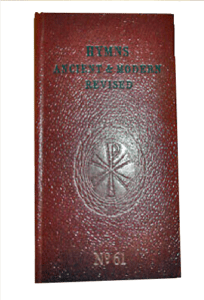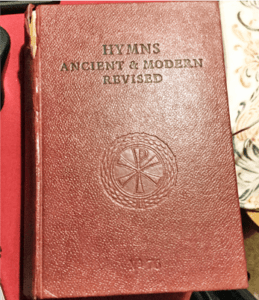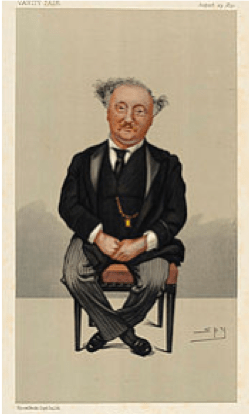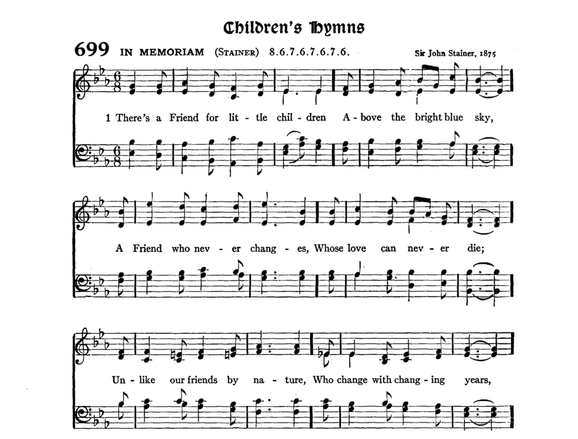My Little Gnudren,
Recently, late one night in bed, old Gnu sat browsing over a hymn beloved from his childhood in Norfolk in the late 1950s. It is found in his much-treasured copy of Golden Bells hymn book. He keeps it next to his bedside Bible as a source of succour in the event of an unexpected spiritual onslaught:

But to his surprise he also found it in the church hymn book when he was appointed as organist and cleaner in a big church in 1976:


close relative, No. 76
Gnu’s much-loved hymn is: There’s a friend for little children above the bright blue sky, words by one Albert Mildane (1825-1909). Not only did the words stir him, but he loved the tune. It brought back happy memories of kindness shown to a migrant infant gnu by the locals, and the Brethren Assembly he was taken to every Sunday morning at Toftwood, just outside East Dereham in Norfolk.
He especially loved the words of verse 3 of this so-called Children’s Hymn, but was also slightly disquieted by them. Here is the verse:
There’s a home for little children
Above the bright blue sky,
Where Jesus reigns in glory,
A home of peace and joy;
No home on earth is like it,
Nor can with it compare;
For everyone is happy,
Nor could be happier there.
Infant Gnu, a confused philosopher in the making, but no longer singing in tongues – he could speak English by now – reasoned thus: Was there a home for grown up adults too in the bright blue sky? Did Jesus want little children to go there now before they grew up to be adults? If he did, wouldn’t it be sad for their parents to part with them. However the beautiful melody ameliorated these disturbing thoughts.
It was only in 1976 that Gnu discovered the tune was written by Sir John Stainer [JS] of ‘The Crucifixion’ fame.

Yes he has been crucified for being a rubbish Victorian composer, especially since the 1960’s era when Sir William Glock reigned at the BBC though it’s not his fault [completely].

Not entirely his fault
Arnold Schoenberg had prophesied that by this time your average schoolboy would merrily skip along to school whistling his favourite 12 note tone row. Old Gnu hasn’t spotted one doing this yet, but he is still on the lookout.

But now a recent discovery; two miracles to ponder:
While organist at Oxford University, JS was also on the committee for the revision of the highly successful Ancient & Modern hymn book that had been published in 1861. He wrote the tune for Old Gnu’s beloved childhood hymn during a committee meeting. Up to now Gnu thought the highest art to be achieved in committee meetings was learning to sleep with your eyes open. But the good Sir John has trumped him.
And now for the second miracle: this hymn and Sir John’s tune survived for over 100 years till the edition of A & M that came out in 1975. He has provided us with many wonderful hymn tunes which we still sing. Not bad for a rubbish Victorian composer. Granted by 1975 the words of this particular hymn do seem a touch patronising and twee, but they sustained young Gnu through not an easy childhood. His school teacher, Miss Coleman frequently found him in the bright blue sky rather than concentrating on his arithmetic.
And finally a conundrum. The good Sir John, was a much loved, kindly man. But why did he call this charming little hymn tune, In Memoriam. It seems hardly appropriate for the name of a children’s hymn tune.
Was it perhaps a comment on his reaction to committee meetings? Gnu thinks not, even though many of us have sat in committee meetings wondering if death is the only way out.
Born to Ann and William, a Southwark cabinet maker who played the violin, at least three of John’s older siblings died in infancy or early childhood. One wonders whether the emotionally sensitive John thought about his departed older child siblings as he sat in that committee meeting, and wrote this tune to Albert Mildane’s words in memorium with them in mind.
As for Sir John himself, the author Peter Charlton writes: “Whatever the reactions to his music in his time, he realised that much of it would not last; it was written to serve a need and he made no pretensions to being a great composer.“
He was a phenomenally brilliant organist and extemporizer. Arthur Sullivan is reported to have said to one of his students: “I was at St Paul’s yesterday, listening to Dr Stainer extemporising. My dear young friends, he is a genius, and I hope you will miss no chance of hearing him.”
Finally Mr. N. Cyclops-Poedia Britonnic writes:
“Stainer’s most lasting contribution is his compilation Early Bodleian Music, with musical examples from the 12th to the 16th century, and Dufay and His Contemporaries (publication begun in 1898), an edition of 15th-century music prepared with the help of his children. Both publications helped open the way to the study of Medieval and Renaissance music, which during Stainer’s time was almost unknown.”

Sir John Stainer
Organist Magdalen College Oxford & Organist of the University Church [St. Mary’s]
Organist of St. Paul’s Cathedral
Professor of Music, Oxford
A jolly good chap with no pretentions.
Vetus Pater Gnu
Academiae Musicorum et Theologia
Turris LA
XX Mensis Februarius MMXX

